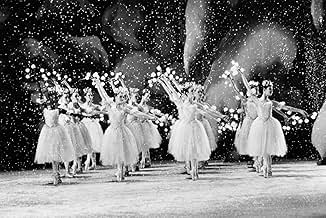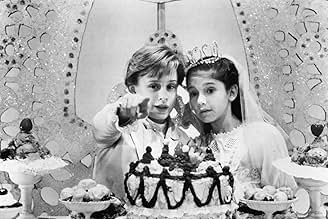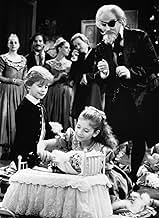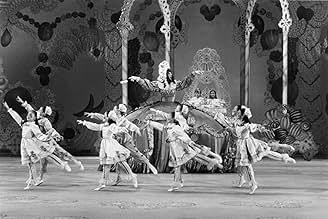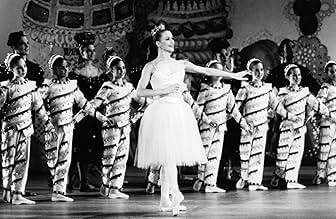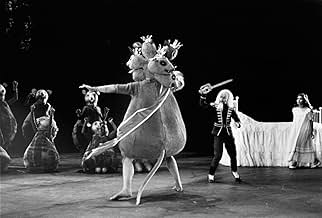IMDb RATING
5.9/10
2.7K
YOUR RATING
On Christmas Eve, a little girl named Marie falls asleep after a party at her house and dreams of a fantastic world where toys become larger than life.On Christmas Eve, a little girl named Marie falls asleep after a party at her house and dreams of a fantastic world where toys become larger than life.On Christmas Eve, a little girl named Marie falls asleep after a party at her house and dreams of a fantastic world where toys become larger than life.
- Director
- Writer
- All cast & crew
- Production, box office & more at IMDbPro
Featured reviews
To begin with, let me first say for the record that I understand that this film was made with the non-Ballet-going public in mind, much as 'E.R.' is made for the non-medical public. This may explain how so many people I have spoken to really loved this film. I, however, must protest. As a professional dancer for many years and, now, a choreographer and director of Ballet, I can not add my voice to the choir of approval that this film has received. Indeed, I have found the production, from front to back with rare exception, to be an ineffectual copy of a classic ballet. The Horror that is Macauly Culkin (who was obviouly cast to bring the film "star-power" rather than talent) aside, the wrongs against Ballet abound aplenty in this film. The choreography is tipical Latter Balanchine (for the un-trained; make it fast, make it sharp and remove any and all elements of Emotion, the core of dance, in favor of a technicality that will highlight the flaws of even the best dancers), the score (considered by many to be their favorite Tchaikovsky piece) is so badly edited and re-arranged that I doubt if the composer would regognize it, leading to the re-arrangement of the staging into a non-linear hodge-podge of dances that tells no deffinite story, but simply ambles through the remains of a once-great narrative and the camera work, while professional and clean, is more distracting than helpful, always cutting away at inopportune moments in favor of another vantage point. One of the wonderful things about watching ballet on tape is being able to see a variation continualy without edits, there-by showing our hero or heroine actually completing a difficult step or combonation, there-by showing off their talent. When one cuts away from a dancer after three fuete turns and then shows them from another angle doing another three fuetes, how are we, as the viewers, to know if the dancer completed all six in one attempt or did she simply do three and WE saw them twice? With the continuity cut from the dancing, much of the magic of ballet (&/or dance in general) gets lost in the mix. And then, there is the Culkin child. Now, I understand that Young Mr. Culkin is rumored to have grown into a very respectable and nice young man. And I also understand (although reports are sketchy) that he received instruction from the School of American Ballet (SAB), the accademy arm of the New York City Ballet (NYCB), for a short time. But does this really qualify him to play the Nutcracker? His obviouly lack of balletic talent or grace and the ham-handed choreography imposed on the child makes his scenes painful to watch and an embarrassment to not only Mr Culkin and the NYCB, but to the entire dancing world. Would it have not made better sense to have cast an actual dancer in the role and let the art form speak for itself rather than trying to "glam" it up with a familar face?
The one shining moment in other-wise waste of video tape is the Soldier Doll Variation performed in the first act Party Scene. Brilliant and incredible!
Needless to say, however, I was disappointed the first time I saw this film and continue to be so now, years later. If you are interested in seeing a quality production of "the Nutcracker", I would like to recomend either the classical and technically perfect Royal Ballet's version or the more visially oppulant Pacific Northwest Ballet's production, both available on video.
The one shining moment in other-wise waste of video tape is the Soldier Doll Variation performed in the first act Party Scene. Brilliant and incredible!
Needless to say, however, I was disappointed the first time I saw this film and continue to be so now, years later. If you are interested in seeing a quality production of "the Nutcracker", I would like to recomend either the classical and technically perfect Royal Ballet's version or the more visially oppulant Pacific Northwest Ballet's production, both available on video.
this is no spoiler I think people have seen this movie The Nutcracker...it was good I loved it...in fact I loved The Nutcracker since I saw it live at the historic Jefferson Theater in Beaumont, Texas in December 1980 when I was 11....loved the music and the growing tree in fact everything in the film was what I remembered seeing live except it was in a movie and I don't understand that person griping cause Macaulay Culkin's outfit was pink it was a nice color....wonder what happened to Jessica Lynn Cohen who played Marie????!!!..is she not acting now????!!!....I know Darci Kistler turned 50 this year and quit the ballet...wonder if any of the other ballet stars who were in the film are still dancing especially Bart Robinson Cook who played Drosselmeier who was Marie's godfather who gave her the Nutcracker who became the prince...I would recommend this movie for anyone for Christmas it's fun and clean and can be seen by anyone
Those who have given this production such a low rating probably have never seen the celebrated George Balanchine production live onstage, or are letting their disdain for the star casting of Macaulay Culkin influence their judgement. The Atlanta Ballet was fortunate enough, from the 1960's to the 1980's, to be the first ballet company authorized to stage this production other than the New York City Ballet, and I have seen it live onstage several times. I can assure readers that the film is a quite accurate rendering of this production, and that the use of a child with limited dancing abilities in the title role is not a cheap stunt dreamed up to showcase Culkin; it was Balanchine's idea to use a child in this role, just as it was his idea to use a child for the role of Marie. The "heavy" dancing is left to the adults in the story.
This is deliberately a stagebound film; in a way, it resembles Laurence Olivier's "Othello". Exactly as in that film, the sets of the stage production have been enlarged to the size of a movie soundstage, but not made any less artificial, and the ballet is straightforwardly photographed with discreet closeups, and without the distracting "music video" quick cuts featured in the 1986 overrated Maurice Sendak-Carroll Ballard version. There are only two false steps in this 1993 film. One is the addition of distracting and completely unnecessary sound effects (mouse squeaks, the children whispering "Ma-gic!" to Drosselmeyer,etc.). Those sound effects are never heard in any stage production of any "Nutcracker", and they have been put in as a cheap concession simply to appease unsophisticated audiences who may not relish the idea of watching a ballet on film.
The other false step is Macaulay Culkin's nutcracker make-up, which looks absolutely ridiculous. When he is on screen as the Nutcracker, rather than wearing a huge mask (as is always done when the Balanchine production is performed onstage), Culkin is actually made up as the toy - he wears what looks like a bald cap, as well as a white wig, whiskers, and a beard. He also has his face rouged up somewhat, and the worst aspect of his make-up is that it is still recognizably his face, amateurishly transformed in a manner similar to Ray Bolger, Jack Haley and Bert Lahr's makeups in "The Wizard of Oz" (that film's makeup results though, worked spectacularly, as this one's does not). And a comparison with Baryshnikov's nutcracker in *his* production shows how wonderfully creative Baryshnikov's nutcracker mask was - the "jaws" actually seemed to move whenever Baryshnikov tilted his head back.
The dancing itself in the Macaulay Culkin version is excellent, of course, except for Culkin himself, whose dancing, as I said, isn't meant to even be spectacular. (The Sugar Plum Fairy and her Cavalier are the prominent dancing roles in Balanchine's production of "The Nutcracker".) The film's colors, though, could be a bit brighter since this IS a fantasy. The choreography is also brilliant, and the adaptation of it is so faithful as to include the sequence that features additional music from Tchaikovsky's ballet "The Sleeping Beauty" - as Marie sneaks downstairs, falls asleep on the sofa, and dreams that Drosselmeyer is "repairing" the broken Nutcracker (this sequence was, of course, never included in Tchaikovsky's original ballet---it is the only sequence in this production which features music from a work other than "The Nutcracker").
Those who have missed out on this film, or those who despise (or loathe it) should give it a chance, despite its two big drawbacks. It is far better than it seems when one first hears that Culkin is in it.
This is deliberately a stagebound film; in a way, it resembles Laurence Olivier's "Othello". Exactly as in that film, the sets of the stage production have been enlarged to the size of a movie soundstage, but not made any less artificial, and the ballet is straightforwardly photographed with discreet closeups, and without the distracting "music video" quick cuts featured in the 1986 overrated Maurice Sendak-Carroll Ballard version. There are only two false steps in this 1993 film. One is the addition of distracting and completely unnecessary sound effects (mouse squeaks, the children whispering "Ma-gic!" to Drosselmeyer,etc.). Those sound effects are never heard in any stage production of any "Nutcracker", and they have been put in as a cheap concession simply to appease unsophisticated audiences who may not relish the idea of watching a ballet on film.
The other false step is Macaulay Culkin's nutcracker make-up, which looks absolutely ridiculous. When he is on screen as the Nutcracker, rather than wearing a huge mask (as is always done when the Balanchine production is performed onstage), Culkin is actually made up as the toy - he wears what looks like a bald cap, as well as a white wig, whiskers, and a beard. He also has his face rouged up somewhat, and the worst aspect of his make-up is that it is still recognizably his face, amateurishly transformed in a manner similar to Ray Bolger, Jack Haley and Bert Lahr's makeups in "The Wizard of Oz" (that film's makeup results though, worked spectacularly, as this one's does not). And a comparison with Baryshnikov's nutcracker in *his* production shows how wonderfully creative Baryshnikov's nutcracker mask was - the "jaws" actually seemed to move whenever Baryshnikov tilted his head back.
The dancing itself in the Macaulay Culkin version is excellent, of course, except for Culkin himself, whose dancing, as I said, isn't meant to even be spectacular. (The Sugar Plum Fairy and her Cavalier are the prominent dancing roles in Balanchine's production of "The Nutcracker".) The film's colors, though, could be a bit brighter since this IS a fantasy. The choreography is also brilliant, and the adaptation of it is so faithful as to include the sequence that features additional music from Tchaikovsky's ballet "The Sleeping Beauty" - as Marie sneaks downstairs, falls asleep on the sofa, and dreams that Drosselmeyer is "repairing" the broken Nutcracker (this sequence was, of course, never included in Tchaikovsky's original ballet---it is the only sequence in this production which features music from a work other than "The Nutcracker").
Those who have missed out on this film, or those who despise (or loathe it) should give it a chance, despite its two big drawbacks. It is far better than it seems when one first hears that Culkin is in it.
I'm not a ballet expert, but I love this production. It's interesting to dissect because there are two camps for this very famous 110 year-old ballet: those who like it as a children's story and those who like it as an adult's. It's been staged both ways in the past as others have already mentioned. This version allows the kids to be front and center, but it has some stellar, sophisticated moments in it as well: the Act 1 finale dance of the snowflakes is a stellar moment of beauty and style, with its ice-blue lighting and costuming and multi-racial Corps De ballet. In Act 2, there's no contest: amongst the innocent dances of the sweets, 'Arabian Coffee' soloist Wendy Whelan sexily attacks the stage in cat-like fashion. The pink-and-purple lighting and floating cinematography and the dancer's serpent-like movements do not resemble any other moment in this already polished film, and one can't help but think that director Emile Ardolino deliberately planned it that way. (It's like watching Ann Reinking or Carol Haney on the Broadway stage.) As far as the smirking Macaulay Culkin is concerned, his presence didn't bother me since he was the right age at the time of filming (and did have some ballet background) and frankly, he smirks in most films he's in. What're you gonna do?
As far as I can recall, Balanchine's alterations to Tchaikovsky's score are as follows:
1) The final section of the Grossvatertanz (a traditional tune played at the end of a party) is repeated several times to give the children a last dance before their scene is over.
2) A violin solo, written for but eliminated from Tchaikovsky's score for The Sleeping Beauty, is interpolated between the end of the party scene and the beginning of the transformation scene. Balanchine chose this music because of its melodic relationship to the music for the growing Christmas tree that occurs shortly thereafter.
3) The solo for the Sugar Plum Fairy's cavalier is eliminated.
It seems to me the accusation that Balanchine has somehow desecrated Tchaikovsky's great score is misplaced.
1) The final section of the Grossvatertanz (a traditional tune played at the end of a party) is repeated several times to give the children a last dance before their scene is over.
2) A violin solo, written for but eliminated from Tchaikovsky's score for The Sleeping Beauty, is interpolated between the end of the party scene and the beginning of the transformation scene. Balanchine chose this music because of its melodic relationship to the music for the growing Christmas tree that occurs shortly thereafter.
3) The solo for the Sugar Plum Fairy's cavalier is eliminated.
It seems to me the accusation that Balanchine has somehow desecrated Tchaikovsky's great score is misplaced.
Did you know
- TriviaNarration recorded by Kevin Kline was a last-minute addition that was heavily protested by Macaulay Culkin's father, Kit Culkin, who vowed that his son would do no publicity for the movie until the narration was dropped. Reluctantly, producer Arnon Milchan dropped the narration to appease the Culkins. Kit Culkin then returned with a list of other demands which so incensed Milchan that he reinstated Kline's narration, losing the use of the Culkins' publicity.
- Crazy creditsIn the opening credits, Macaulay Culkin is listed as playing Drosselmeier's nephew, but he is not listed as playing either The Nutcracker or The Prince.
- Alternate versionsThe Warner Bros. Family Entertainment logo is removed from the 2015 DVD due to 20th Century Fox, later Disney who acquired Fox in 2019, owning a 20% stake in Regency.
- SoundtracksThe Nutcracker: Overture
(uncredited)
Music by Pyotr Ilyich Tchaikovsky
The New York City Ballet Orchestra (with chorus) conducted by David Zinman
- How long is The Nutcracker?Powered by Alexa
Details
- Release date
- Country of origin
- Official site
- Language
- Also known as
- Cascanueces
- Filming locations
- New York City, New York, USA(Studio)
- Production companies
- See more company credits at IMDbPro
Box office
- Budget
- $19,000,000 (estimated)
- Gross US & Canada
- $2,119,994
- Opening weekend US & Canada
- $783,721
- Nov 28, 1993
- Gross worldwide
- $2,119,994
- Runtime1 hour 32 minutes
- Sound mix
- Aspect ratio
- 1.85 : 1
Contribute to this page
Suggest an edit or add missing content




